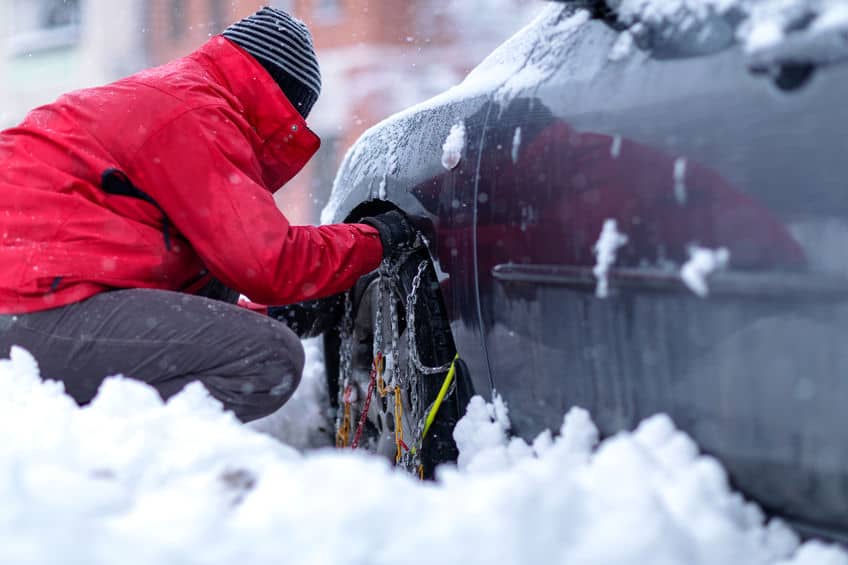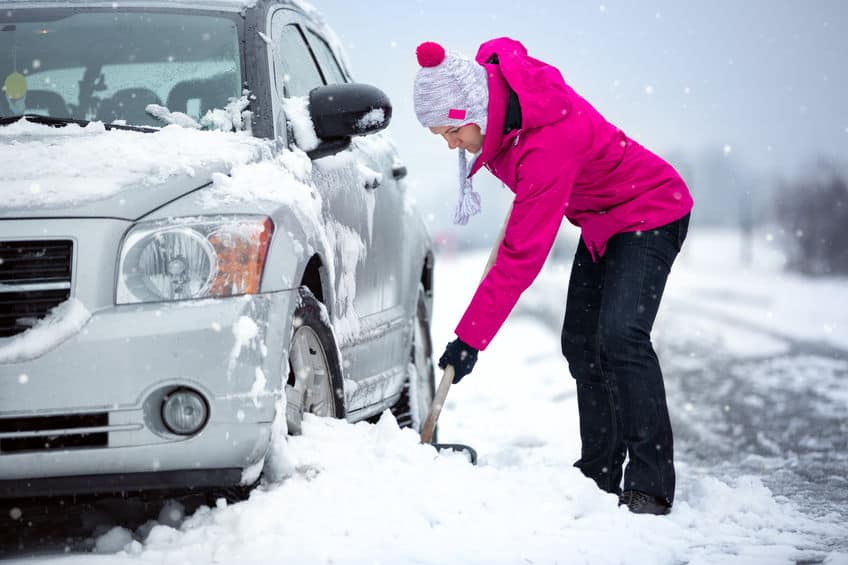
Winter Driving Essentials
Winterize Your Car
Before the snow even starts to fall it’s important to do some small tasks to make sure your vehicle is winter-ready. We recommend setting an annual calendar event for your winter driving preparation on your phone as a way to help make it a habit. In Colorado, we typically get our first snowfall in late October. Even if you get a few months into the season, it’s not too late to take care of any of these tasks you missed.
Maintenance Tasks
Make sure your routine maintenance is up to date. This includes oil and filter changes and fluid level checks, especially the antifreeze. While your car is with your mechanic, make sure they check your battery and replace it if necessary.
Replace your windshield wipers with winter-grade wipers. This may seem like a small thing, but it can have a big impact on safety. The right wipers ensure that you have good visibility even in harsh winter driving conditions. For a list and reviews of the top ten winter blades, check out this great article by AutoGuide.com.
Invest in winter washer fluid. When temperatures drop your standard washer fluid is likely to freeze. It’s important to swap out for a specialty fluid during those cold winter months. You can purchase a replacement fluid, an additive to your existing fluid (either liquid or tablets), or a concentrate. Your local auto parts associate should be able to help you choose the best option for your vehicle.
Get snow tires and check your tire pressures. Winter tires are made with rubber that’s softer and more pliable. This helps get better traction on ice and snow. More traction means the driver has better control of the vehicle. If you’re not able to put snow tires on your car, your next best bet is to ensure your tires are properly inflated. For every 10 degrees that the temperature drops, tires can lose 1-2 pounds of air pressure. Check the vehicle manufacturer’s recommended tire pressure on the door placard and keep an eye on the tire pressure during the colder months. Many tire stores offer complimentary air checks and will top off your tires with air for free.
Take the time to practice or brush up on common winter tasks. Standing in a blizzard is not the ideal time to try to put chains on for the first time. Take a few minutes to brush up on things like how to use jumper cables, change a tire, and put on snow chains before the winter driving season begins. Cold fingers and poor conditions can make these things even more challenging! The right preparation can save you a lot of time, discomfort, and frustration.

If you have an older car, restore your headlights. When the polycarbonate that protects your headlights ages it becomes cloudy and yellow which can affect performance. There are several easy-to-use, affordable products on the market that can help you restore their translucence and your headlight’s brightness. Check out this video from Project Farm about The Best Headlight Restoration Kits for some reviews and instructions for how to use them.
Make Your Winter Driving Emergency Kit
Make sure you have an emergency kit in your vehicle. You never know what may happen when you are out on the road, but inclement weather certainly increases your risks. You are more likely to get stuck, snowed in, or stranded. It’s important to put supplies in your trunk so you are able to get back on the road safely and quickly. If you aren’t able to get back on the road you need to be prepared to stay safe while you wait for help. We suggest the following items for your emergency kit:
- A flashlight and extra batteries or a crank flashlight
- A small snow shovel and an ice scraper
- Extra gloves, winter hat, and a blanket
- Hand and boot warmer packets (we like the HeatMax brand)
- Bottled water
- A first aid kit (this should be in your car year-round)
- Jumper cables and a tow strap, especially if you have an older car

Other things you may want to include are road flares, a multi-tool, kitty litter (or sand) for traction. If you will be driving in the mountains you may want to have tire chains. Put the items listed above in every vehicle you own. Make sure your teen driver knows where the emergency kit is stored and how to use the items in an emergency situation.
Things To Remember When You Go Out
De-ice your windows. Scraping the ice off your windshield and windows can be difficult, but it doesn’t have to be. There are product on the market that can help de-ice your windows quickly and safely. We like Prestone and RainX brand de-icers.
If you want to DIY, you try this recipe. Fill a spray bottle with two parts rubbing alcohol to one part of water. Add ½ teaspoon of liquid dish detergent for every 2 cups. Shake the bottle to mix it. Be sure to label it as de-icer spray. Use at your own risk.
Always remove all snow from your vehicle before putting it in motion. Clean your side mirrors and cameras and remove snow or ice from any sensors for assistive driving features. Be careful to remove all snow from your hood so it doesn’t blow up against your windshield, blocking your line of sight. Remove it from your roof and the back of your car so that the snow doesn’t inadvertently fly back and block the view of the driver behind you.
Never leave a vehicle running in your garage. It’s dangerous because carbon monoxide from your exhaust can build up to unsafe levels. Never leave it running in your driveway because it’s illegal.
Safety All Winter Long
Get driver training to increase your skill and confidence in icy and snowy conditions. If you’ve never had formal training from an expert you are missing out. We have a Winter Driving Course specifically to help both teens and adults be safer and feel more confident even in the worst conditions Colorado weather can throw at them. During your driving course, you will learn a lot about handling reduced visibility, navigating slippery roads, and emergency situations. Click here to learn more and get registered today before spots fill up!
Slow down and leave more room for stopping. 4 wheel drive doesn’t mean 4 wheel stop. Make sure that your teen understands that just because a vehicle has 4WD doesn’t mean that breaking capability is increased when 4WD is engaged. Gentle acceleration from a full stop as well as controlled breaking to come to a stop are equally important in slippery conditions.
Make sure to keep at least one quarter to half a tank of gas in your tank in case you get stranded. Fill up before taking longer trips and stop more frequently for gas instead of waiting until you’re almost empty.
Wash your car more often to prevent damage from the chemicals put on the roads during the winter. Magnesium Chloride is a common deicer sprayed by CDOT (Colorado Department of Transportation). If it stays on your car for extended periods it can cause damage to your car, like rust and corrosion. We recommend a wash about every two weeks or so depending on how much you’re driving. Be sure to pick a day that the temperature is above freezing.
